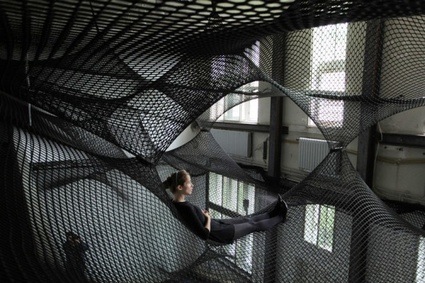 NET at Z33, 2011. Image Numen / For Use
NET at Z33, 2011. Image Numen / For Use
There is only one week left for you to run to the House for Contemporary Art Z33 in Hasselt and bounce around the amazing work that Numen / For Use has created especially for the art center.
This is the second time this year that i’ve encountered the work of the design collective. I discovered their work in Spring when i was attending a press conference at CCCS – Strozzina in Florence. Sven Jonke, Christoph Katzler and Nikola Radeljkovic had wrapped transparent tape all over the courtyard of the venerable Palazzo Strozzi to shape a self-supporting cocoon for people to crawl inside. For Z33, they’ve left the gaffer tape in Vienna and Zagreb (where they are based) and used nets to turn the whole exhibition space into a giant playground that can be explored horizontally as well as vertically. The idea might look incredibly simple but the result evokes floating architecture and flexible, aerial “landscape” as much as jungle gym.
I was beyond happy when Nikola and Christoph accepted to discuss their work with me. The interview focuses mostly on the Net at Z33 and on the Tape walk-in installation i saw in Florence but the Numen/ For Use website will, i’m sure, give you many more reasons to admire their work.
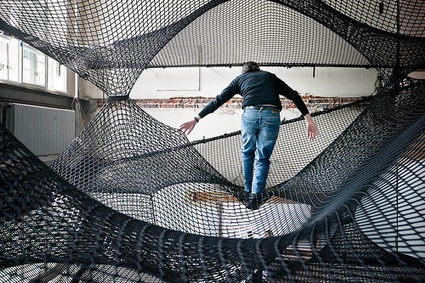 Numen / For Use – NET, 2011, Z33, Hasselt, Belgium (photo: Kristof Vrancken / Z33)
Numen / For Use – NET, 2011, Z33, Hasselt, Belgium (photo: Kristof Vrancken / Z33)
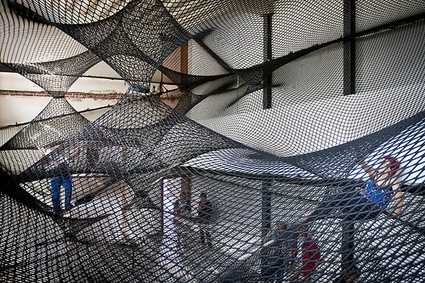 Numen / For Use – NET, 2011, Z33, Hasselt, Belgium (photo: Kristof Vrancken / Z33)
Numen / For Use – NET, 2011, Z33, Hasselt, Belgium (photo: Kristof Vrancken / Z33)
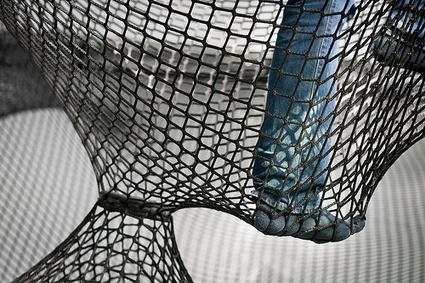 Numen / For Use – NET, 2011, Z33, Hasselt, Belgium (photo: Kristof Vrancken / Z33)
Numen / For Use – NET, 2011, Z33, Hasselt, Belgium (photo: Kristof Vrancken / Z33)
Sorry if i’m going to start on a very trivial note but one of the first questions that popped into my mind was “how about security?” I’m sure your installations are perfectly safe and sound but is ‘health and safety’ ever an issue? Are there any special measure you have to comply with and did they ever get in the way of your creativity?
Christoph: Security and safety is always the thing we fight with. Since we are educated as applied artists and since we do a lot of set design in theatre we are aware of all the problems concerning statics and security.
It is part of every daily reality. Especially when you make something in public space you have to fight with a lot of law issues. But often they are rather idiotic issues. It is bizarre to see how different countries and different organizers are putting weight and importance concerning law on totally different things and how they ignore others totally. But it is also interesting that in art institutions law is very often not seen so super strict like in other fields. This is one reason why I like to work there.
Up to now it was like this that either the ideas went without bigger problems into realization or they stopped very early due to some legal regulations.
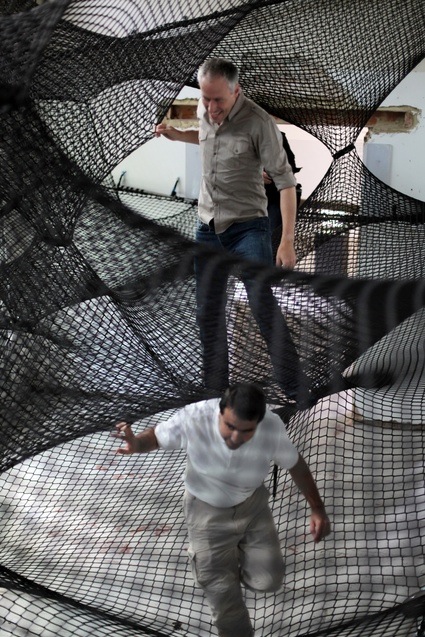 NET at Z33, 2011. Image courtesy of Numen / For Use
NET at Z33, 2011. Image courtesy of Numen / For Use
How did you get to create The Net for Z33? Did they give you carte blanche or did you work on the idea together with the curator?
Christoph: We said, “we want to try something new.” They said, “okay but we need the idea within two weeks”, which was rather a short period for us to find something we really like. But the idea came actually easy and fast, which is rather rare, and we all were rather satisfied from the beginning.
Artist talk with Numen / For Use about NET | Z33
In the video interview that you did for Z33, you explain that The Net is a testbed for a public version that could be installed between houses. Have you found a location already? Would you see it as a permanent structure or a nomadic one?
Christoph: YES, we are searching for a nice location in public to realize it there! In the opposite to our other walk-in installation (called Tape) it is much harder to find a location in the public space. Many of my friends would love to have it in there backyard to open the window and to jump inside for a sun-bath or whatever. But I do guess it would be difficult to find a location where all neighbors would give there permission to have “strangers” hanging around in front of there windows.
Another possibility would be to use one of those football-cages where kids are playing and to implant it there. It would be a different situation, but I think it still would work.
Probably it has to be temporary due to the law and safety regulations ; – )
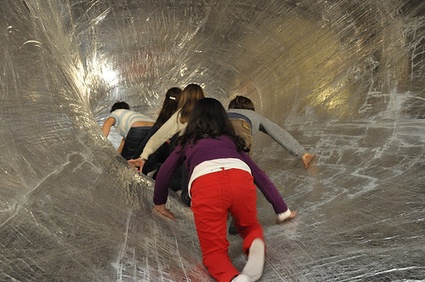 Numen / For Use, Tape Florence, 30.04.2011 – 20.05.2011. View of installation in the courtyard of Palazzo Strozzi, Firenze. Photo: Martino Margheri
Numen / For Use, Tape Florence, 30.04.2011 – 20.05.2011. View of installation in the courtyard of Palazzo Strozzi, Firenze. Photo: Martino Margheri
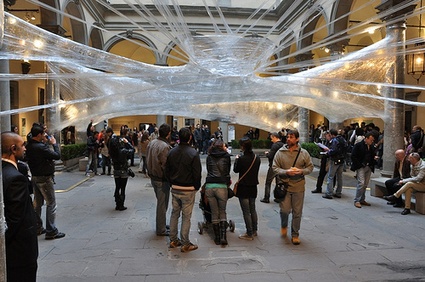 Numen / For Use, Tape Florence, 30.04.2011 – 20.05.2011. View of installation in the courtyard of Palazzo Strozzi, Firenze. Photo: Martino Margheri
Numen / For Use, Tape Florence, 30.04.2011 – 20.05.2011. View of installation in the courtyard of Palazzo Strozzi, Firenze. Photo: Martino Margheri
When i saw the Tape installation in the courtyard of Palazzo Strozzi in Florence, it was morning, there was a press conference, and none of the journalists was climbing inside the structure. Actually, i had no idea anyone was allowed to or even that anyone would think of doing it. The public is usually not supposed to climb into sculptures/installations. But somehow, i found the work fascinating enough. What is most important to you, that the public will want to engage physically with your work or that they are visually compelling?
Christoph: For us it is 100% important that the public can go inside and experience these works. Nowadays we write it in our contracts that the public has to be able to go inside during normal opening hours. When people see the installations most of them are curious, they want to go inside. But since you have to take your shoes off and crawl an all four it makes the social borders falling. They are starting to enjoy it together in a very communicative way although they often do not even know each other. This is nice! That’s why we like to see it in the public. Maybe it is somehow like in a different world and some rules do not count anymore for a while.
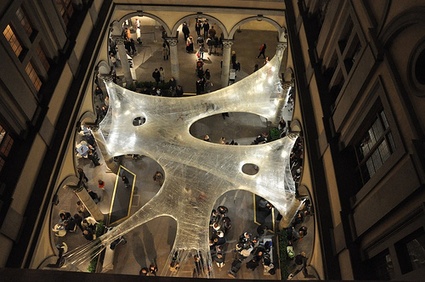 Numen / For Use, Tape Florence, 30.04.2011 – 20.05.2011. View of installation in the courtyard of Palazzo Strozzi, Firenze. Photo: Martino Margheri
Numen / For Use, Tape Florence, 30.04.2011 – 20.05.2011. View of installation in the courtyard of Palazzo Strozzi, Firenze. Photo: Martino Margheri
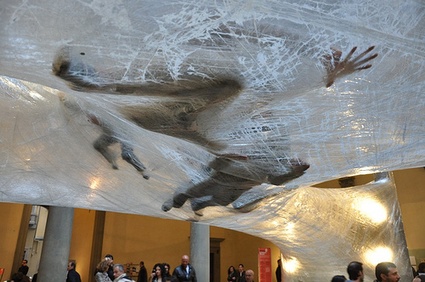 Numen / For Use, Tape Florence, 30.04.2011 – 20.05.2011. View of installation in the courtyard of Palazzo Strozzi, Firenze. Photo: Martino Margheri
Numen / For Use, Tape Florence, 30.04.2011 – 20.05.2011. View of installation in the courtyard of Palazzo Strozzi, Firenze. Photo: Martino Margheri
The Tape shapes are very organic (at least to me.) How do they form? Do you have to work on computer models first to explore the sturdiness and elegance? Or is there rather much space for improvisation?
Christoph: We make just a simple model to test somehow the basic shapes not to be totally wrong and the rest we do on spot rather following our intuition. So there is no computer involved at all! We also do not draw or design a lot. It is basically just working, working working, because what ever you do it will always shrink into forms which are geometrically perfect! On spot it is a real rush and chaos, everybody is doing something. So in the beginning we often think we made some mistakes. But now we know that it is just the usual phase. We just go on and it is fine at the end.
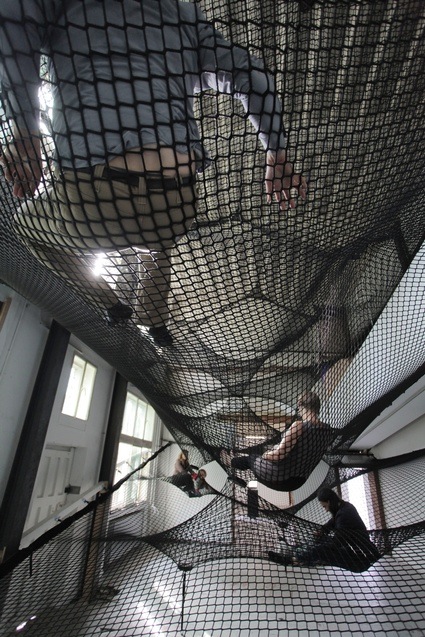 NET at Z33, 2011. Image courtesy of Numen / For Use
NET at Z33, 2011. Image courtesy of Numen / For Use
You trained as industrial designers, but what you do now seems to be miles away from industrial design. Would you agree with that statement? Or do you feel that your practice evolved in a logical way and that, no matter what you are doing today, you are still true to your roots as industrial designers?
Nikola: It seems but it is not. Industrial design implies a certain awareness of the needs and wishes of the user and we consider the visitors of our installations in that way. Designers are constantly trying to personalize products and production, to humanize mass produced items. On the other hand, we are at the moment seriously working on industrializing our installations, in the sense that we are developing a walk-in installation which can be set over and over again. Our working process and professional ethos are still strongly influenced by our design roots and I find it stimulating to exchange influences and experiences from one field to another. The strict border between art and design is, in my opinion, totally artificial and absurd. Both fields are about visual communication of abstract values, about media and society, both use creative potentials to articulate spatial relations and both constantly refer to one another. It was like this even before pop art and after…
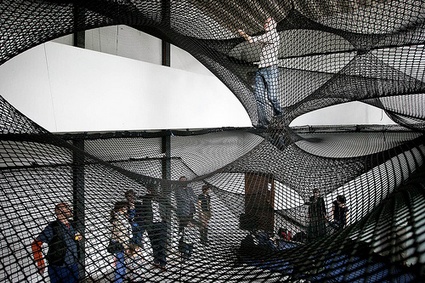 Numen / For Use – NET, 2011, Z33, Hasselt, Belgium (photo: Kristof Vrancken / Z33)
Numen / For Use – NET, 2011, Z33, Hasselt, Belgium (photo: Kristof Vrancken / Z33)
Does For Use still find time to design chairs and other pieces of furniture or have the more artistic projects completely taken over your time and energy?
Christoph: I am at the moment mostly into the experimental projects because I feel much more freedom and I see much more joyful feedback from the audience. But we still deal with design and I do guess we will approach different to that profession in the future and open up our borders.
Nikola: Since Christoph is avoiding design completely, I am probably dealing with design more that ever!-)
Thanks Christoph and Nikola!
Making of NET – Numen / For Use
You have until October 2nd to jump in the NET at the House for Contemporary Art Z33 in Hasselt, Belgium.
This interview is going to be part of a catalogue i’m currently working on with the Z33 team. The book should be out in early 2012 and Z33 has allowed me to publish on the blog a couple of the interviews i had with the artists, architect and designers they have been working with over the past few months.
